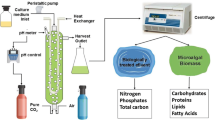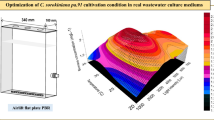Abstract
In this study, the effect of mixotrophic, heterotrophic, photoautotrophic (CO2 of air source), and photoautotrophic (bicarbonate source) cultivation of Chlorella vulgaris was investigated on microalgae growth rate and nutrient removal under different kinds of nitrogen sources. The highest N–NH3+, N–NO3−, P–PO43− (in ammonium source), and P–PO43− (in nitrate source) removal efficiency (87.28 ± 0.89, 70.00 ± 1.20, 87.00 ± 3.10, and 78.10 ± 1.95%, respectively) was reached in the mixotrophic culture. In all cultivations, when nitrate was used as the nitrogen source, specific growth rate, biomass productivity, and specific oxygen production rate (SOPR) were higher than the one with ammonium source due to decreased pH. However, in all cultures except for photoautotrophic cultivation (in the CO2 of the air), nitrogen removal rates improved in the ammonium source. In addition, in both ammonium and nitrate source, the respiration activity of mixotrophic microalgae was higher than the photosynthetic activity of the cells. When CO2 was used as inorganic carbon, the specific growth rate of microalgae was lower than with the bicarbonate source. Based on the obtained results, mixotrophic conditions would be the most useful cultivation for application in N-rich wastewater treatment systems.







Similar content being viewed by others
References
Ahmad I, Hellebust J (1984) Nitrogen metabolism of the marine microalgae Chlorella autotrophica. Plant Physiol 76(3):658–663
Anthonisen AC, Loehr RC, Prakasam TBS, Srinath EG (1976) Inhibition of nitrification by ammonia and nitrous acid. J Water Pollut Contr Fed 48:835–852
APHA (2005) Standard methods for the examination of water and wastewater, 21st edn. American Public Health Association, NewYork
Aslan S, Kapdan I (2006) Batch kinetics of nitrogen and phosphorus removal from synthetic wastewater by algae. Ecol Eng 28(1):64–70
Azov Y, Goldman JC (1982) Free ammonia inhibition of algal photosynthesis in intensitive cultures. Appl Environ Microbiol 43(4):735–739
Babaei A, Mehrnia MH, Shayegan J, Sarrafzadeh MH (2016) Comparison of different trophic cultivations in microalgal membrane bioreactor containing N-riched wastewater for simultaneous nutrient removal and biomass production. Process Biochem 51:1568–1575
Borowitzka MA (1988) Algal growth media and sources of algal cultures. In: Borowitzka MA, Borowitzka LJ (eds) Microalgal biotechnology. Cambridge University Press, Cambridge, pp 456–465
Chen GQ, Chen F (2006) Growing phototrophic cells without light. Biotechnol Lett 28:607–616
Chen F, Johns MR (1991) Effect of C/N ratio and aeration on fatty acid composition of heterotrophic Chlorella sorokiniana. J Appl Phycol 3:203–209
Di Caprio F, Altimari P, Pagnanelli F (2015) Integrated biomass production and biodegradation of olive mill wastewater by cultivation of Scenedesmus sp. Algal Res 9:306–311
Dubey KK, Kumar S, Dixit D, Kumar P, Kumar D, Jawed A, Haque S (2015) Implication of industrial waste for biomass and lipid production in Chlorella minutissima under autotrophic, heterotrophic, and mixotrophic grown conditions. Appl Biochem Biotechnol 176(6):1581–1595
Fenton O, O hUallachain D (2012) Agricultural nutrient surpluses as potential input sources to grow third generation biomass (microalgae): a review. Algal Res 1:49–56
Flynn KJ (1991) Algal carbon–nitrogen metabolism: a biochemical basis for modeling the interactions between nitrate and ammonium uptake. J Plankton Res 13(2):373–387
Ge SH, Champagne P (2016) Nutrient removal, microalgal biomass growth, harvesting and lipid yield in response to centrate wastewater loadings. Water Res 88:604–612
Goldman JC (1976) Phytoplankton response to wastewater nutrient enrichment in continuous culture. J Exp Mar Biol Ecol 23(1):31–43
Jalal KCA, Zahangir Alam MD, Matin WA, Kamaruzzaman BY, Akbar J, Toffazel H (2011) Removal of nitrate and phosphate from municipal wastewater sludge by Chlorella vulgaris, Spirulina platensis and Scenedesmus quadricauda. IIUM Eng J 12(4):125–132
Ji MK, Kim HC, Sapireddy VR, Yun HS, Abou-Shanab RA, Choi J, Lee W, Timmes TC, Jeon BH (2013) Simultaneous nutrient removal and lipid production from pretreated piggery wastewater by Chlorella vulgaris YSW-04. Appl Microbiol Biotechnol 97(6):2701–2710
Kallqvist T, Svenson A (2003) Assessment of ammonia toxicity in tests with the microalgae, Nephroselmis pyriformis, Chlorophyta. Water Res 37(3):477–484
Kandimalla P, Desi S, Vurimindi H (2016) Mixotrophic cultivation of microalgae using industrial flue gases for biodiesel production. Environ Sci Pollut Res 23:9345–9354
Kang R, Wang J, Shi D, Cong W, Cai Z, Ouyang F (2004) Interactions between organic and inorganic carbon sources during mixotrophic cultivation of Synechococcus sp. Biotechnol Lett 26(18):1429–1432
Kim J, Lingaraju BP, Rheaume R, Lee JY, Siddiqui KF (2010) Removal of ammonia from wastewater effluent by Chlorella Vulgaris. Tsinghua Sci Technol 15(4):391–396
Kim S, Park JE, Cho YB, Hwang SJ (2013a) Growth rate, organic carbon and nutrient removal rates of Chlorella sorokiniana in autotrophic, heterotrophic and mixotrophic conditions. Bioresour Technol 144:8–13
Kim S, Lee Y, Hwang SJ (2013b) Removal of nitrogen and phosphorus by Chlorella sorokiniana cultured heterotrophically in ammonia and nitrate. Int Biodeter Biodegr 85:511–516
Liang Y, Sarkany N, Cui Y (2009) Biomass and lipid productivities of Chlorella vulgaris under autotrophic, heterotrophic and mixotrophic growth conditions. Biotechnol Lett 31(7):1043–1049
Lika K, Papadakis IA (2009) Modeling the biodegradation of phenolic compounds by microalgae. J Sea Res 62(2):135–146
Lin TS, Wu JY (2015) Effect of carbon sources on growth and lipid accumulation of newly isolated microalgae cultured under mixotrophic condition. Bioresour Technol 184:100–107
Lowrey J, Brooks MS, McGinn PJ (2015) Heterotrophic and mixotrophic cultivation of microalgae for biodiesel production in agricultural wastewaters and associated challenges—a critical review. J Appl Phycol 27:1485–1498
Madadi R, Pourbabaee AA, Tabatabaei M, Zahed MA, Naghavi MR (2016) Treatment of petrochemical wastewater by the green algae Chlorella Vulgaris. Int J Environ Res 10(4):555–560
Markou G, Vandamme D, Muylaert K (2014) Microalgal and cyanobacterial cultivation: the supply of nutrients. Water Res 65:186–202
Marquez FJ, Sasaki K, Kakizono T, Nishio N, Nagai S (1993) Growth characteristics of Spirulina platensis in mixotrophic and heterotrophic conditions. J Ferment Bioeng 76(5):408–410
Martinez ME, Sánchez S, Jiménez JM, Yousfi F, Muñoz L (2000) Nitrogen and phosphorus removal from urban wastewater by the microalga Scenedesmus obliquus. Bioresour Technol 73(3):263–272
Min M, Hu B, Zhou W, Li Y, Chen P, Ruan R (2012) Mutual influence of light and CO2 on carbon sequestration via cultivating mixotrophic alga Auxenochlorella protothecoides UMN280 in an organic carbon-rich wastewater. J Appl Phycol 24(5):1099–1105
Pagnanelli F, Altimari P, Trabucco F, Toro L (2014) Mixotrophic growth of Chlorella vulgaris and Nannochloropsis oculata: interaction between glucose and nitrate. J Chem Technol Biotechnol 89(5):652–661
Perez-Garcia O, De-Bashan LE, Hernandez JP, Bashan Y (2010) Efficiency of growth and nutrient uptake from wastewater by heterotrophic, autotrophic, and mixotrophic cultivation of Chlorella vulgaris immobilized with Azospirillum brasilense. J Phycol 46(4):800–812
Perez-Garcia O, Escalante FME, de-Bashan LE, Bashan Y (2011) Heterotrophic cultures of microalgae: metabolism and potential products. Water Res 45:11–36
Pourasgharian F, Mehrnia MR, Asadi A, Moayedi Z, Ranjbar R (2014) Effect of microalgae/activated sludge ratio on cooperative treatment of anaerobic effluent of municipal wastewater. Appl Biochem Biotechnol 172:131–140
Rodrigues MS, Ferreira LS, Converti A, Sato S, Cavalho JC (2010) Fed-batch cultivation of Arthrospira (Spirulina) platensis: potassium nitrate and ammonium chloride as simultaneous nitrogen sources. Bioresour Technol 101(12):4491–4498
Shi XM, Zhang XW, Chen F (2000) Heterotrophic production of biomass and lutein by Chlorella protothecoides on various nitrogen sources. Enzyme Microb Tech 27(3):312–318
Shi J, Podola B, Melkonian M (2007) Removal of nitrogen and phosphorus from wastewater using microalgae immobilized on twin layers: an experimental study. J Appl Phycol 19:417–423
Terry KL, Raymond LP (1985) System design for the autotrophic production of microalgae. Enzyme Microb Tech 7(10):474–487
Velasco PJ, Tischner R, Huffaker RC, Whitaker JR (1989) Synthesis and degradation of nitrate reductase during the cell cycle of Chlorella sorokiniana. Plant Physiol 89:220–224
Yeesang C, Cheirsilp B (2014) Low cost production of green microalga Botryococcus braunii biomass with high lipid content through mixotrophic and photoautotrophic cultivation. Appl Biochem Biotechnol 174:116–129
Zheng Y, Chi Z, Lucker B, Chen S (2012) Two stage heterotrophic and phototrophic culture strategy for algal biomass and lipid production. Bioresour Technol 103(1):484–488
Acknowledgements
The authors are grateful to the University of Tehran for supporting this research. In addition, this research was financially supported by Grant No. 11.68722 from the Vice-Presidency for Science and Technology (Presidency of the Islamic Republic of Iran) and the Tehran Province Water and Wastewater Company.
Author information
Authors and Affiliations
Corresponding author
Rights and permissions
About this article
Cite this article
Babaei, A., Mehrnia, M.R., Shayegan, J. et al. Evaluation of Nutrient Removal and Biomass Production Through Mixotrophic, Heterotrophic, and Photoautotrophic Cultivation of Chlorella in Nitrate and Ammonium Wastewater. Int J Environ Res 12, 167–178 (2018). https://doi.org/10.1007/s41742-018-0077-z
Received:
Revised:
Accepted:
Published:
Issue Date:
DOI: https://doi.org/10.1007/s41742-018-0077-z




